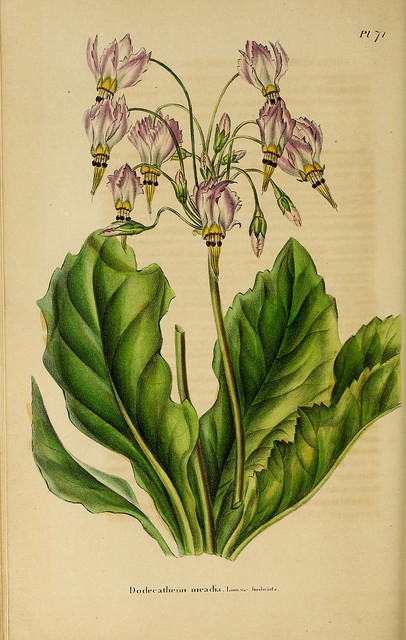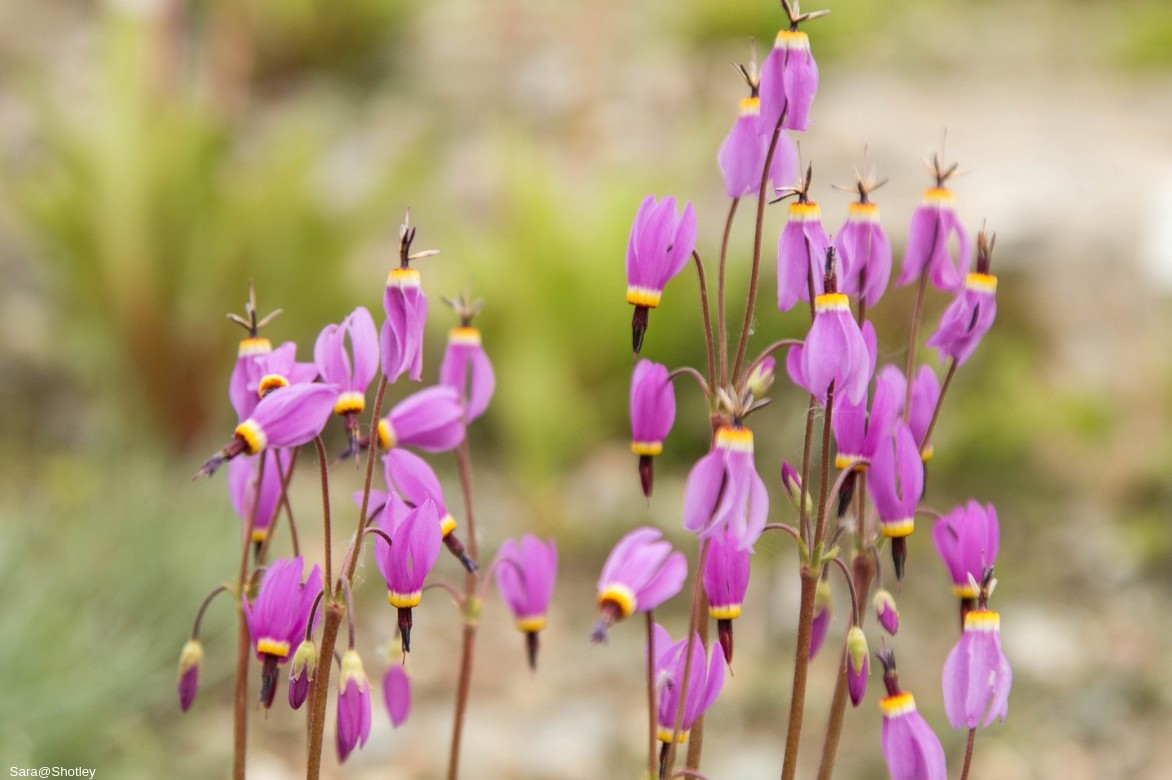
Shooting star, Virginia cowslip: planting, growing
Contents
Dodecatheon in a nutshell
- Dodecatheon is one of the prettiest spring flowering displays!
- Its delicate upturned flowers, reminiscent of miniature cyclamens, declinate into charming shades of pink
- This small perennial for moist shade requires acid soil that is consistently fresh and well-drained
- Very hardy, easy to establish in woodland understorey beneath tree foliage
- Also thrives in cool rockeries, borders or shady beds
A word from our expert
Dodecatheon or Virginia gyroselle has one of the most beautiful spring flowerings! Still too little known, this flower of rare beauty, until now known mainly to discerning collectors, deserves to feature prominently in every garden, well sheltered beneath tree foliage.
In spring, this small, very elegant perennial displays with infinite grace delicately turned-back flowers resembling miniature cyclamens in purplish-pink or white.
Dodecatheon meadia or Virginia gyroselle or Dodecatheon pulchellum, all create slightly sophisticated scenes tinged with freshness.
But don’t be fooled by their appearance: beneath that graceful look lies a very hardy perennial that’s easy to grow with other lovely shade-loving perennials.
This moist-shade perennial only needs dappled shade, cool conditions and a rather acidic, cool, well-drained soil to flower generously before fading away quietly in summer.
Endearing and elegant, discover our gyroselles, those little botanical jewels to collect; they are perfect for dressing a shaded rockery, tree bases or a shrub border.
And take inspiration from our spring-flowering perennials to accompany them!
Description and botany
Botanical data
- Latin name Dodecatheon
- Family Primulaceae
- Common name Gyroselle, Dodecatheon
- Flowering April to June
- Height 0.15 to 0.40 m
- Sun exposure partial shade, shade
- Soil type acidic, fresh
- Hardiness -15°C
Dodecatheon, also called gyroselle, is a perennial herbaceous plant of family Primulaceae, cousin of primroses and cyclamens, native to cool woodlands, damp meadows and sometimes alpine areas of North America.
Genus includes 14 species, among which Dodecatheon meadia or Virginia gyroselle is most widespread. It has produced some interesting cultivars such as ‘Queen Victoria’. Only four species are marketed in our country and Dodecatheon jeffreyi, Dodecatheon hendersonii and Dodecatheon pulchellum are rarely offered for sale.
Slow-growing, gyroselle forms in spring a clump of erect leaves arranged in a basal rosette. It reaches 10 to 45 cm in height. Oval to lanceolate, spatulate or obovate, measuring 2 to 25 cm long, leaves are sometimes irregularly dentate. Glabrous or slightly velvety and fleshy, they resemble those of primroses. From tender green to dark green, they sometimes redden towards the petiole depending on variety. Deciduous foliage regenerates in spring.

Dodecatheon meadia – botanical illustration
Graceful and infinitely delicate, gyroselle’s flowering is of rare beauty. From March to June depending on climate, numerous floral stalks, slender yet vigorous, rise well above the foliage, sometimes to over 40 cm tall. At the tip of these bare greenish-pink stems, slightly arched, hang gracefully umbels of around fifteen flowers revealing a calyx of 5 fully reflexed sepals. Their singular shape, with narrow lanceolate petals turned backwards and borne on long peduncles, inevitably recalls that of mini-cyclamens.
Like suspended in air and turned towards the sky, they open in clouds of small inverted bells 1 to 3 cm long in colours ranging from pastel pink, cyclamen pink to raspberry or cherry red, more rarely cream-white; these flowers are slightly white at the base. The flower centre, highly visible, reveals a pointed cluster of 5 stamens fused together and protruding, brown-purple or deep violet, ringed with golden-yellow, orange or white.
As a celestial ode, this fairy-like flowering would pay homage to the twelve gods of Olympus; in Greek “dodeca” means “twelve” and “theos” “gods”.
Like every good spring plant, gyroselle has a very short vegetative cycle; after flowering it enters dormancy, losing its foliage during summer and disappearing completely.
Very hardy to between -15°C and -25°C, Dodecatheon prefers cool, mountainous climates. This small perennial plant of damp woodlands requires filtered light or partial shade and humus-bearing, acidic soil that remains very fresh, even moist during the growth period and is well drained.
Read also
Care of perennial plantsMain species and varieties
Dodecatheon meadia or Virginia shooting-star is the most widespread species, and occurs in numerous varieties displaying all shades of pink from pale to carmine, as well as white.
Our favourites

Dodecatheon meadia Queen Victoria
- Flowering time May, June
- Height at maturity 35 cm

Dodecatheon meadia
- Flowering time May, June
- Height at maturity 30 cm
Discover other Dodecatheon
View all →Available in 1 sizes
Available in 1 sizes
Available in 1 sizes
Available in 1 sizes
Available in 3 sizes
Planting
Where to plant gyroselle or Dodecatheon?
From its montane origins, Gyroselle has retained considerable hardiness, able to withstand temperatures around −15°C and sometimes down to −25°C. It is very much at ease in rather cool climates and in a mountain garden.
Although it tolerates cold well, this small shade-loving plant of moist conditions does have some cultural requirements, making it delicate to grow in Mediterranean climate, which is a little too dry. Avoid strong sun exposure and dried-out soils.
This understorey perennial is happiest in partial shade or in shaded but bright areas in non-calcareous soil, slightly acidic, rich in humus, remaining consistently cool, even moist during growth, and well drained. It will, however, appreciate a slightly drier soil during summer dormancy.
Choose position carefully because once well established, this plant does not tolerate transplanting well.
Install it at edge of a bed or in a cool shady rockery, on woodland edge or beneath tree foliage that will protect it from scorching rays and where in spring it will form lovely, short-lived but very floriferous clumps.
Particularly fond of moisture, it will also do well on pond margins.
When to plant gyroselle or Dodecatheon?
Planting of Dodecatheon is done in early spring in March–April after frosts or from September to November.
How to plant gyroselle or Dodecatheon?
Soil must be well drained and rich in organic matter to plant Gyroselle. Space plants 30–40 cm apart to allow clumps to develop freely and allow 5 to 7 buckets per m². As foliage dies back early in summer, to fill bare ground and take over after flowering, consider planting between two gyroselle plants some small summer bulbs or other perennials that enjoy cool to moist soils and shady positions.
- Clear soil thoroughly by removing stones, roots and weeds
- Work soil well, adding a mix of turf and leaf mould
- Dig a hole two to three times pot volume
- Lay a draining layer of gravel or coarse sand
- Plant and cover rootball with fertile soil mix
- Water generously to encourage rooting
- Mulch in spring with pine bark to keep soil cool

Dodecatheon redolens
Read also
Planting Perennials and BushesCare and maintenance
Once established, Dodecatheon requires almost no maintenance and proves to be a trouble-free perennial, able to live for many years without any care, provided soil remains consistently moist, especially during flowering.
It does not tolerate very dry soil: if necessary water regularly once or twice a week during growth so soil remains fresh.
After flowering, leaves collapse onto soil, then deciduous foliage disappears in summer, leaving plant in dormancy underground and making it hard to spot — which is just as well since it requires no watering during this period! That said, we recommend marking its location to avoid damaging it when weeding and to make control of gastropods easier as growth begins.
Remove faded flower stalks if desired, which look untidy after flowering, and cover the stump with a tapetum of dry leaves.
Unaffected by disease, it has few enemies: slugs and snails that devour young leaves in spring. Follow our advice to keep them at bay naturally!
Multiplication
If sowing is possible, we recommend instead dividing the rosettes in spring on stumps at least three years old, to rejuvenate the plant and maintain good flowering.
Divide clumps of Gyroselle
- Using a spade, gently lift the clump to remove a division with a rosette of leaves
- Replant immediately in the garden in well-worked, deep soil
Pairing Dodecatheon in the garden
Le Dodecatheon est essentiel shade perennial pour apporter colour et freshness au cœur du printemps, dans un wooded garden, utilisé en groundcover en sous-bois frais, sous des deciduous trees or bushes ou en a pit dans une rocaille d’ombre humide.
Graceful, avec ses flowers roses, plus rarement blanches, il fleurit dans tous les nature-inspired gardens, créant des scènes fraîches, dans des associations discrètes ou pimpantes. Dans un pink garden or romantic, associez-le à des hardy fuchsias, des Dicentra spectabilis ou Bleeding Heart.

An idea for a shady combination: Dodecatheon meadia, Meconopsis betonicifolia, Lamium orvala, Geranium nodosum ‘Silverwood’, Hosta tardiana ‘Halcyon’ et vous pouvez compléter avec quelques touffes de Polypodium vulgare
Il fera merveille associé à des cyclamens, des white daffodils, des snowdrops, erythronium et autres spring bulbs tels que des early tulips, les scillas et les muscari qui seront également de bons companions.
Les petites shade-loving perennials comme les primroses ou des violas composeront avec lui des compositions délicates.
Dans une rocaille ombragée, aux abords d’un water feature, on l’accompagnera d’Epimedium, des pulmonarias, de petites ferns, d’astilbes, d’hostas et de rodgersias.
Pour couvrir un talus, il s’associera parfaitement à des Corydalis, creeping bugles ou à des petits groundcovers, comme le Chrysosplenium oppositifolium, qui combleront le vide laissé par la gyroselle pendant la dormancy estivale.
Et inspirez-vous de nos idées pour planter sous vos arbres !
Useful resources
- How to make the most of shade in the garden? Discover our tips on our blog!
- What to plant under your trees?
- Gyroselle brings pink to the garden! A must in a romantic garden!
- Ideal for filling a bare woodland understorey, a shaded bank or dressing the base of a tree, fall for our unique collections of shade-loving perennials!
- Subscribe!
- Contents






































Comments